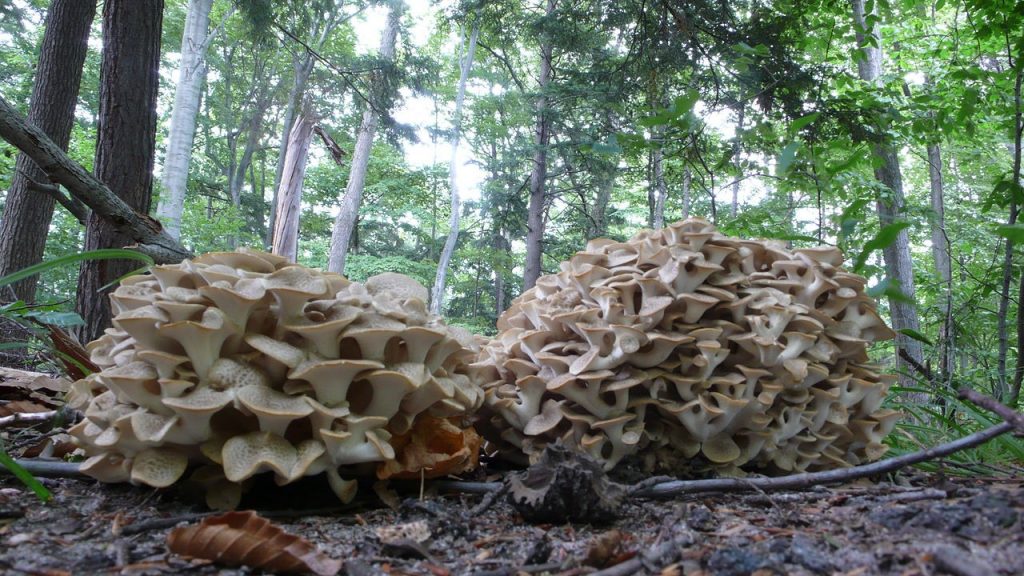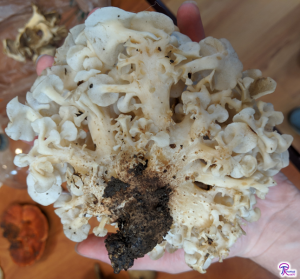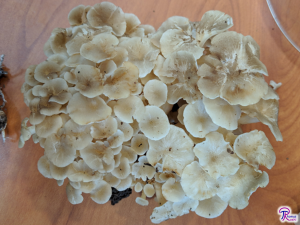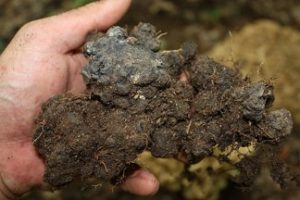#227: Polyporus umbellatus, the Umbrella Polypore

I have never found Polyporus umbellatus, but apparently I’m not alone. This mushroom has a wide range that covers the whole northern hemisphere but the mushrooms are still uncommon. Known as the “Umbrella Polypore,” P. umbellatus forms rosettes on the ground under hardwood trees. The central stalk branches repeatedly and each branch ends in a circular umbrella-like cap (hence its common name). Umbrella Polypores appear in the spring just after morel season and sometimes reappear in the fall. The fungus is a weak parasite and can feed on its host trees for decades, so after you find one once, you know where to find some next year! The mushroom is considered edible and medicinal, although different parts are used for each purpose.1–4
Description
The Umbrella Polypore looks something like a bouquet of tiny umbrellas stuck in the ground. The whole rosette grows 10-50cm across, although each individual cap grows only 1-5cm across. The circular pilei start out convex but flatten as they grow and eventually develop a central depression. Caps are whitish to greyish to greyish brown and usually feature small dark scales or fibers, at least when young. As the mushroom ages, it discolors yellow. Underneath the pileus, the mushroom’s spore-producing surface is arranged into pores. The pores are white and angular and are run down the stipe a long way. The pores release white spores. Supporting each pileus is a whitish stipe that attaches to the center of the pileus. Near the base, the mushroom has a single stipe. This stipe branches repeatedly to create the evenly-spaced rosette of caps above it.1–4

Underground, P. umbellatus forms a large sclerotium (a dense collection of fungal cells that serves as a food storage structure). The sclerotium is black and irregularly lumpy and can easily grow over 30cm across. On the inside, the sclerotium is white and solid. The Umbrella Polypore’s mushrooms sprout directly from its sclerotium.2,4
Ecology
The Umbrella Polypore is a weak parasite on the roots and wood of broadleaf trees and will continue to decompose wood after the tree dies. As a result of this association, the mushrooms always appear on the ground. P. umbellatus grows all over the northern hemisphere, appearing on North America, Asia, and Europe. Despite this broad range, it is a rare mushroom that you’re not likely to find. P. umbellatus fruits in the spring, summer, and fall, although they typically appear from May to June (just after morel season) and sometimes fruit again in September and October.1–4 I know a couple people in my area who have P. umbellatus trees that reliably produce mushrooms during the first week of May.
P. umbellatus might have some kind of relationship with Armillaria, since Armillaria rhizomorphs are often found in the Umbrella Polypore’s sclerotium.5,6 It is not clear what kind of relationship this is, but people cultivating P. umbellatus find that the fungus produces larger sclerotia when Armillaria is present.6

Similar Species
Grifola frondosa (Hen of the Woods, FFF#103) is the only mushroom similar to P. umbellatus. Like P. umbellatus, G. frondosa is a polypore that grows from the ground in branched rosettes with small pilei. However, G. frondosa produces caps that attach to their stalks on the edge rather than at the center as in P. umbellatus. Additionally, G. frondosa usually appears in the fall at the bases of oak trees.7
Edibility
The Umbrella Polypore is considered a choice edible mushroom, if you’re lucky enough to find it. It has a strong flavor that works well in many different dishes. The mushrooms quickly attract flies and start decomposing. Once decomposition begins, the mushroom develops an acrid flavor; you’ll want to pick these soon after they appear.3,4
P. umbellatus is harvested in China for the medicinal properties of its sclerotium. The sclerotium – known as zhu ling – is dried, powdered, and taken in small amounts on a daily basis. Zhu ling is considered a diuretic, anti-inflammatory, and immune booster. Traditionally, it is used to treat various lower body fluid retention problems, including edema, urinary tract infections, vaginal discharge, and similar symptoms.8–10

Taxonomy
The taxonomy of Polyporus umbellatus is not very well resolved. It is currently placed in Polyporus, which mostly contains stalked polypores. This seems like a good placement, but because of DNA mycologists may have to transfer it to another genus. Older field guides call this mushroom Grifola umbellata due to its superficial resemblance to Grifola frondosa.1
Additionally, P. umbellatus might be a species complex; Asian specimens have a lot of genetic variation, which could indicate the presence of multiple species. If mycologists decide to split P. umbellatus into multiple species, the American variety will probably need a new name. So, get ready to learn a new genus and species name for this mushroom!1
The scientific name translates to “polypore with umbrellas”; essentially, the scientific and common names have the same meaning!2
| Kingdom | Fungi |
| Subkingdom | Dikarya |
| Division | Basidiomycota |
| Subdivision | Agaricomycotina |
| Class | Agaricomycetes |
| Order | Polyporales |
| Family | Polyporaceae |
| Genus | Polyporus |
| Species | Polyporus umbellatus (Pers.) Fr.11 |
This post is not part of a key and therefore does not contain enough information to positively identify any mushroom. When collecting for the table, always use a local field guide to identify your mushrooms down to species. If you need a quality, free field guide to North American mushrooms, I recommend Michael Kuo’s MushroomExpert.com. Remember: when in doubt, throw it out!
See Further:
https://www.mushroomexpert.com/polyporus_umbellatus.html https://www.messiah.edu/Oakes/fungi_on_wood/poroid%20fungi/species%20pages/Polyporus%20umbellatus.htm https://www.first-nature.com/fungi/polyporus-umbellatus.php http://www.midwestmycology.org/Mushrooms/Species%20listed/Polyporus%20umbellatus%20species.htmlCitations
- Kuo, M. Polyporus umbellatus. MushroomExpert.Com (2015). Available at: https://www.mushroomexpert.com/polyporus_umbellatus.html. (Accessed: 10th May 2019)
- Emberger, G. Polyporus umbellatus. Fungi Growing on Wood Available at: . (Accessed: 10th May 2019)
- O’Reilly, P. Polyporus umbellatus (Pers.) Fr. – Umbrella Polypore. First Nature Available at: https://www.acupuncturetoday.com/herbcentral/polyporus.php. (Accessed: 10th May 2019)
- Polyporus umbellatus. Midwest American Mycological Information Available at: https://www.acupuncturetoday.com/herbcentral/polyporus.php. (Accessed: 10th May 2019)
- Kikuchi, G. & Yamaji, H. Identification of Armillaria species associated with Polyporus umbellatus using ITS sequences of nuclear ribosomal DNA. Mycoscience 51, 366–372 (2010).
- Xing, X., Men, J. & Guo, S. Phylogenetic constrains on Polyporus umbellatus – Armillaria associations. Scientific Reports 7, 4226 (2017).
- Kuo, M. Grifola frondosa. MushroomExpert.Com (2017). Available at: https://www.acupuncturetoday.com/herbcentral/polyporus.php. (Accessed: 10th May 2019)
- Yang, Y. & Al-Khafaji, M. Chapter Six – Herbs that transform Dampness. in Chinese Herbal Medicines: Comparisons and Characteristics (eds. Yang, Y. & Al-Khafaji, M.) 81–92 (Churchill Livingstone, 2010). doi:10.1016/B978-0-7020-3133-5.00012-9
- Borten, P. Zhu Ling – Polyporus umbellatus sclerotium (mushroom) – Grifola umbellatus. Chinese Herbal Medicine (2013). Available at: https://chineseherbinfo.com/zhu-ling-polyporus-sclerotium-grifola-mushroom/
- Polyporus (zhu ling). Acupuncture Today (2019). Available at: https://www.acupuncturetoday.com/herbcentral/polyporus.php. (Accessed: 10th May 2019)
- Polyporus umbellatus. Mycobank Available at: http://www.mycobank.org/Biolomics.aspx?Table=Mycobank&Rec=22515&Fields=All. (Accessed: 11th May 2019)

![#089: Polyporus squamosus, the Dryad’s Saddle [Archived]](https://www.fungusfactfriday.com/wp-content/themes/hueman/assets/front/img/thumb-medium-empty.png)





![#011: Characteristics of Kingdom Fungi [Archived]](https://www.fungusfactfriday.com/wp-content/themes/hueman/assets/front/img/thumb-small-empty.png)

Thanks for the great information. Helped me figure out what I was finding.